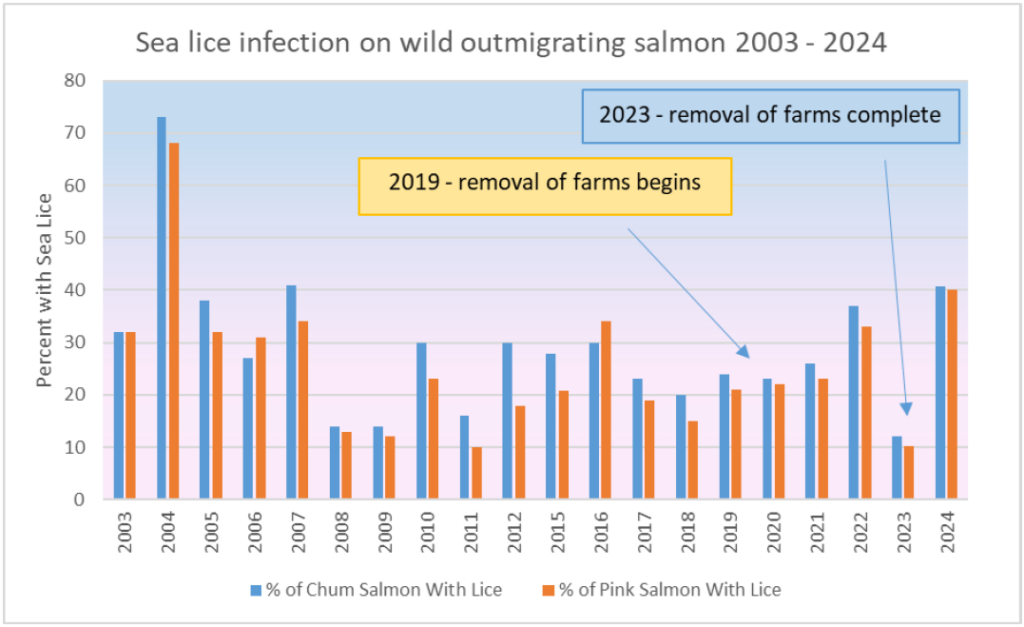CAMPBELL RIVER, BC – An extensive literature review has identified overestimates of the effects of sea lice from salmon farms on wild Atlantic salmon. The study, which reviewed the Norwegian regulatory management of the salmon farming sector, also concluded that sea lice infections on farms are not associated with a measurable impact on wild salmon. The information was recently published in a peer-reviewed scientific journal, Reviews in Aquaculture.
“This is an important finding, as it aligns with the research and data we are seeing on sea lice in Canada,” says Simon Jones, Emeritus Scientist of Fisheries and Oceans Canada (DFO) and co- author of the published review. “The highly variable relationship between lice levels on wild salmon and salmon aquaculture in BC indicates the need for a greater understanding of all factors affecting the survival of wild salmon.”
Additionally, newly released 2024 data from the Broughton Archipelago wild juvenile salmonoid monitoring program further supports that salmon farms do not impact sea lice levels on wild salmon, as the variability in the percentage of sea lice on wild Pacific salmon remains unchanged (see Figure 1 in Appendix) despite the removal of salmon farms in the area. The average intensity (number of lice per fish) of wild Pacific salmon with sea lice has also remained low for the last 20 years (see Table 1 in Appendix).
Sea lice are marine parasites naturally occurring in the ocean and have coexisted with wild salmon for millions of years. Farm-raised salmon enter the ocean free of sea lice, and the BC Salmon Farmers, under DFO’s and First Nations’ stringent regulations, diligently practice precautionary management measures to minimize sea lice transmission from farmed to wild salmon.
A 2023 Science Response from the Canadian Science Advisory Secretariat (CSAS) and long-term data collected annually in the Discovery Islands by registered professional biologists[¹] also concluded that sea lice on farm-raised salmon do not impact sea lice levels on wild juvenile salmon in British Columbia.
“The continued exaggeration of wild salmon populations declining due to sea lice from salmon farms does not help conservation efforts of wild salmon. Ongoing research and data support that the salmon farming sector poses minimal risk to wild Pacific salmon, yet government decisions continue to ignore the science and threaten our sector’s future,” says Brian Kingzett, Executive Director of the BC Salmon Farmers Association.
“BC Salmon Farmers support wild salmon restoration, climate action and food security. It’s time for the federal government to stop using salmon farming as a scapegoat, making unrealistic and unachievable political decisions about our sector, and focus on reliable data and science to address the real issues impacting wild Pacific salmon,” says Kingzett.
ABOUT THE BC SALMON FARMERS ASSOCIATION
BC salmon farmers are committed to reconciliation, and all farms operating in BC are currently in agreement, negotiation, or established partnerships with First Nations in whose territories we operate. These agreements are founded upon recognizing First Nations’ right to exercise jurisdiction over the land, resources, and waters within their territories.
Farm-raised salmon generates over $1.142 billion for the provincial economy, supporting thousands of jobs. Additionally, farm-raised salmon provides a nutritious and sustainably produced protein with a low carbon footprint that contributes to Canada’s food security and
Blue Economy.
The BC Salmon Farmers Association represents over 60 businesses and organizations throughout the value chain of finfish aquaculture in BC. Our members account for over 95% of the annual provincial harvest of farm-raised salmon in British Columbia.
For more information, visit bcsalmonfarmers.ca.
MEDIA CONTACT
Michelle Franze
Manager of Communications, Partnerships and Community
michelle@bcsalmonfarmers.ca
604-202-4417
APPENDIX

Figure 1. Percentage of chum and pink salmon with sea lice (L. salmonis and/or C. clemensi) in the Broughton Archipelago during the spring out-migration. Original graph from Modern Salmon Farming: A Review: Chapter 10 – Sea Lice Management (page 59). The graph has been updated with 2024 data. Original graph adapted from Patanasatienkul et al[²].
Table 1. Percentage of chum and pink salmon with sea lice (L. salmonis and/or C. clemensi) and average intensity (# lice/fish) for chum and pink salmon that have lice in the Broughton Archipelago during the spring out-migration. Data 2003-2012 from Patanasatienkul et al., 2015-2024 data from Mainstream Biological Consulting.
REFERENCES
[¹]College of Applied Biologists, Governance Documents, Bylaws, Policies and Standards https://cab-bc.org/about-the-college/governance-documents-bylaws-policies-and-standards/ [²]Patanasatienkul T, Sanchez J, Rees EE, Krkošek M, Jones SR, Revie CW. 2013. Sea lice infestations on juvenile chum and pink salmon in the Broughton Archipelago, Canada, from 2003 to 2012. Diseases of Aquatic Organisms.105(2):149-161, https://www.int-res.com/abstracts/dao/v105/n2/p149-161
